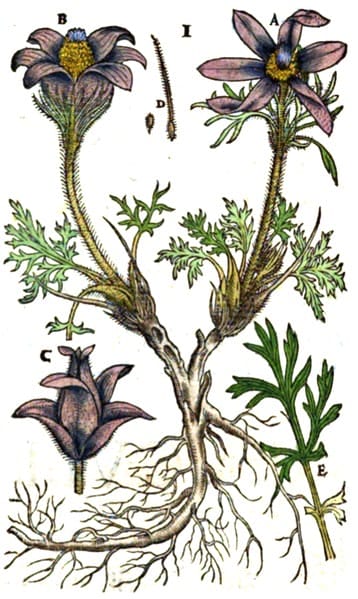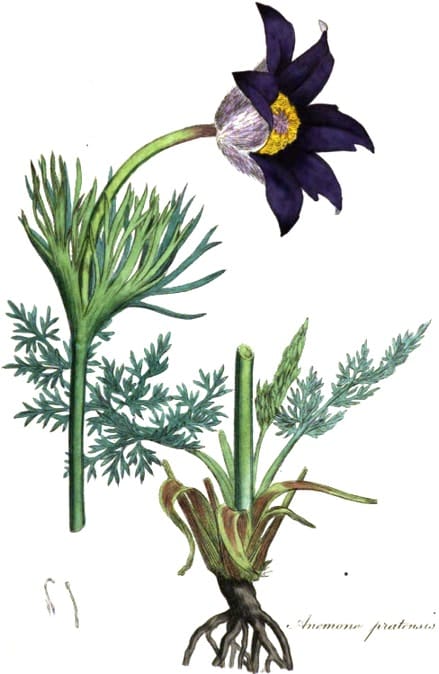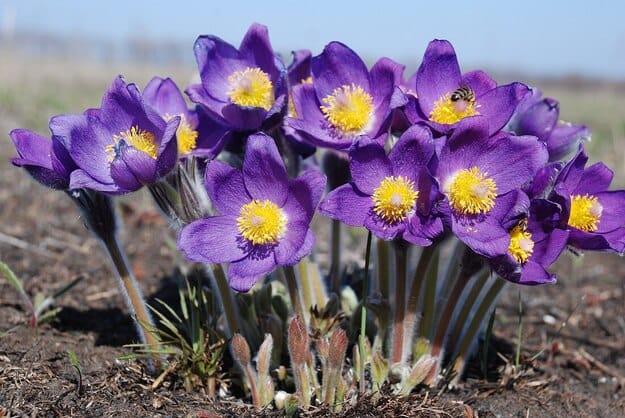Pulsatilla, Pasque flower, Bai Tou Weng 白头翁
Anemone, Wood Anemone, Windflower, Herb VentiiShaqiq, Shaqaq-un-Noman (Unani)
Chinese Pulsatilla is Bai Tou Weng
 Anemone
AnemoneKreutterbuch, Matthiolus, 1586 |
 A. pratensis
A. pratensisMedical Botany, Woodville, Vol III, 1810 |
 Anemone patens
Anemone patens(Photo by GalinaGouz) (Wkimedia)
Botanical name:
Three varieties of Anemone were listed in the Pharmacopoeias:
i. Meadow Anemone: Anemone patens (syn. Pulsatilla patens)
ii. Garden Anemone: Anemone pulsatilla (syn. P. pulsatilla, P. vulgaris)
iii. Wood or Wild Anemone: P. nemorosa (syn. A. nemorosa)
Salmon described 1. Single Anemone; 2. Double Anemone; 3. Great Wild or Wood Anemone; 4. Smaller Wild or Wood Anemone
Chinese Pulsatilla (Bai Tou Weng) is from P. chinensis although a number of local varieties are used including P. koreana.
Various species have been used in Europe, Asia and the U.S., and appear fairly synonymous.
Parts used:
Whole herb dried; Root
Temperature & Taste:
Cool, dry. Bitter, Pungent. Slightly Toxic
It was classed as Warm and dry in the West, but based on the use, the Chinese classification as Cold seems more appropriate.
Classification:
B. Clears Heat and Toxin
Attenuate, Incide, Cephalic, Uterine, Arthritic
Uses:
1. Clears Damp-Heat, Resists Poison: (TCM, West)
-Dysentery (amoebic and bacillary) (TCM, West)
-Toxic Sores, Abscesses (TCM, West)
-acute inflammatory conditions and pain of the Testes or Prostate;
-turbid Leukorrhea and foul discharge;
-Chinese variety is effective against Trichomonas and Candida;
-Gout and Rheumatism.
-various Poisons and Epidemic diseases (West)
-Malarial disorders (TCM)
2. Settles Wind, Benefits the Eyes and Vision: (TCM, West)
-acute and recurrent heat conditions of the eyes such as Styes, Conjunctivitis etc. (TCM, West)
-tearing on exposure to wind
-deep-seated pain of the eyes;
-poor vision from eye strain or sexual excess;
-chronic eye disorders including those of Diabetes, and threatened Blindness.
-Tinnitus.
3. Settles Wind, Moves the Qi and Blood, Calms the Mind: (West)
-Apoplexy, Epilepsy, Lethargy, Vertigo, Madness (Salmon)
-Insomnia, Tension, tension Headaches, Migraine, Dizziness, nervous exhaustion, especially in women.
-recommended for PMS, Depression associated with Infertility
-Irritability with a tendency to look at the negative.
-Despondency, Nervousness, Sadness, and for crying for no reason, or crying while asleep
-Fear for no reason.
-“pale neurasthenic children, who are restless, with active imaginations” (Prof. Mundy, a specialist in Children’s diseases)
4. Moves the Blood, Clears Heat, Promotes Menstruation: (West)
-‘the leaves provoke the terms mightily, being boiled, and the Decoction drank’ (Culpeper)
-painful or delayed periods with scanty or suppressed menstrual flow
-menstrual or labor pain with fear, tension or debility
-Ovarian pain and Mittleshmertz
-long used during pregnancy to ease Labor and avoid complications of pregnancy.
-Good for symptoms of Menopause and PMS.
-Orchitis, Prostatitis
5. Clears Heat, Stops Coughs:
-Spasmodic Coughs, Whooping Cough, Bronchitis and Asthma.
6. Promotes Milk:
-the roots boiled until their taste dissipates, then eaten in salads was used to increase Milk
7. Externally:
i. applied topically to boils, and some skin eruptions
ii. traditionally as a wash for Leprosy
iii. an ointment made of the fresh herb was used for ‘malignant and corroding Ulcers’; Running Sores, old Ulcers and Fistulas (Salmon)
iv. the related Chinese species is also used for chronic and ulcerated Scrofula.
v. The oil or tincture can be dropped into the ears for Earache
vi. topically for Warts.
vii. compress is applied to tenderness of the ovary (Ellingwood)
viii. it pessaries, with wax and Barley meal to promote menstruation
ix. The juice snuffed up the nose, or the root chewed in the mouth was used to clear the head of all ‘watery and phlegmatic humors’, and was therefore recommended for Lethargy.
Dose:
Powder: 1–3 grams
Long Infusion or Decoction: 3–9 grams (up to 15 grams in TCM)
Tincture (1:10): 15–45 drops;
Fluid Extract (1:1): 5–10 drops.
Comment:
1. Pulsatilla is one of the herbs that is widely spread and has been used in various systems. In general, their general appearance and functions are consistent, with a large number of local varieties having been used from East to West.
2. The Chinese Pulsatilla Bai Tou Weng is Cold and Bitter. It is used to clear Heat and Poison, Cool the Blood and stop Diarrhea. It is primarily used for Dysentery-like disorders, but has classically been used for other Heat-Toxin symptoms such as Malarial disorders with delirium, Scrofula, Toothache and acute heat-type Joint pain. The Eastern and Western Pulsatilla can be considered largely interchangeable.
Main Combinations:
1. Palpitations with Arrhythmias:
i. Pulsatilla with Lily of the Valley
ii. Pulsatilla with Hawthorn
2. To prevent Thrombosis and Embolism during pregnancy, and to ease Labor, Pulsatilla with St. John’s wort, Yarrow (European formula)
3. Dysmenorrhea:
i. Pulsatilla with Pennyroyal and Rue
ii. from Cold, Pulsatilla with Ginger
iii. and Amenorrhea, combine with Black Haw, Black Cohosh or Gelsemium (Eclectics, Lloyd)
4. Menopause:
i. Pulsatilla with Motherwort
ii. with depression, Pulsatilla with St. Johns wort
iii. with hot flashes, Pulsatilla, Sage, Motherwort, Cinnamon, Licorice
5. Nervousness, Hysteria during Pregnancy, Pulsatilla with Black Cohosh is small, frequent doses. (Lloyd)
6. PMS, Pulsatilla with St. Johns wort, Balm
7. Anxiety:
i. Pulsatilla with Lavender
ii. Pulsatilla with Valerian
iii. Pulsatilla with Lavender, Sage, Valerian
8. Insomnia, Anxiety:
i. Pulsatilla with Valerian
ii. Pulsatilla with Valerian, Lavender, Licorice
9. Fear, Pulsatilla, Rue, St. Johns wort, Schisandra, Licorice
10. Heat-Toxin Diarrhea or Dysentery:
i. Pulsatilla with Purslane
ii. Pulsatilla Bai Tou Weng with Coptis Huang Lian (Ben Cao Gang Mu)
iii. with sore throat Pulsatilla Bai Tou Weng with Coptis Huang Lian, Costus Mu Xiang (Ben Cao Gang Mu)
iv. Chinese Pulsatilla Bai Tou Weng is used with Phellodendron Huang Bai, Coptis Huang Lian
11. Malarial disorders, Chinese Pulsatilla Bai Tou Weng with Bupleurum Chai Hu, Scutellaria Huang Qin, Areca Bing Lang (Betel nut)
12. As a strong Diuretic, decoct Pulsatilla with Barley husk (Unani)
13. Dysuria, Pulsatilla with Black Cohosh, Agrimony (Ellingwood)
14. Asthma:
i. Pulsatilla with Lobelia
ii. Pulsatilla with Ephedra, Schisandra, Licorice
15. Whooping Cough, Pulsatilla with Valerian, Fennel (Sobernheim, 1840)
16. Orchitis, Pulsatilla with Poke root, Gelsemium or Aconite (Boskowitz, 1909)
17. Wash for Vaginal discharge with itchiness, Chinese Pulsatilla Bai Tou Weng with Sophora Ku Shen
Major Formulas:
Bai Tou Weng Tang
Cautions:
1. Toxic in large doses. The Fresh plant is highly irritant.
2. Use cautiously during pregnancy, in small doses, and best avoided during the first trimester.
Toxicity:
Symptoms of poisoning include nausea, vomiting, loose bowels, hematuria, dilated pupils, coma, and convulsions
